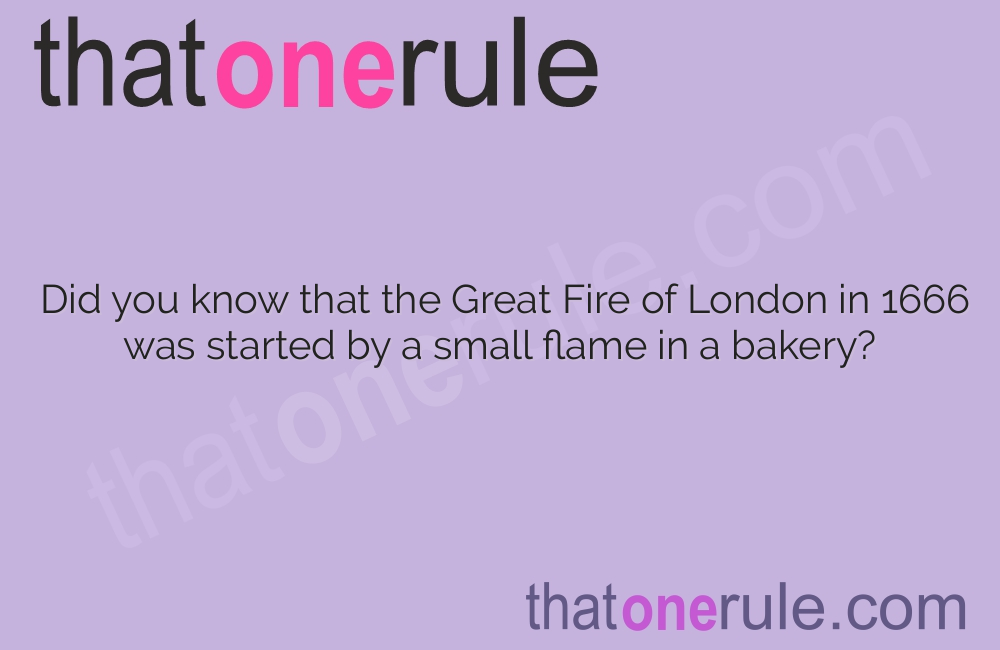Crazy History Facts

Did you know that the Great Fire of London in 1666 was started by a small flame in a bakery?
The longest war in history is the Three Hundred and Thirty Five Years’ War between the Netherlands and the Isles of Scilly.
Catherine the Great of Russia had a collection of 7,000 dresses.
In 1896, the average life expectancy in the United States was only 47 years.
The shortest war in history lasted only 38 to 45 minutes. It was the Anglo-Zanzibar War in 1896.
During the French Revolution, the entire French calendar system was redesigned, resulting in 10-day weeks.
The first recorded divorce took place in ancient Egypt around 3000 BC.
The city of Rome was originally built on seven hills.
The fastest pirate in history was François l’Olonnais, who could run at incredible speeds and became known as The Running Pirate.
In 1903, the Wright brothers made their first powered flight, lasting only 12 seconds and covering 120 feet.
King Henry VIII of England had a special horned helmet made for him that he would wear during battles.
In 1912, the RMS Titanic sank after hitting an iceberg, resulting in the loss of over 1,500 lives.
The shortest-reigning monarch in history was Louis Antoine of France, who was king for only 20 minutes.
The Underground Railroad, a network of secret routes and safe houses used by escaped slaves in the 19th century, wasn’t actually underground.
The Great Wall of China is not visible from space, contrary to popular belief.
Crazy History Facts part 2
In 1889, the Eiffel Tower was completed in Paris and stood as the tallest man-made structure for over 40 years.
The London Bridge has been moved and rebuilt multiple times throughout history.
The guillotine, a device used for execution during the French Revolution, was named after French doctor Joseph-Ignace Guillotin, who advocated for a more humane method of execution.
The first recorded Olympic Games were held in 776 BC in Olympia, Greece.
Julius Caesar was assassinated by a group of Roman senators led by Brutus in 44 BC.
The Taj Mahal was built in memory of Emperor Shah Jahan’s wife, Mumtaz Mahal.
Cleopatra, the last pharaoh of Egypt, was actually Greek, not Egyptian.
The Great Pyramid of Giza was the tallest man-made structure in the world for over 3,800 years.
In 1626, Dutch colonist Peter Minuit bought the island of Manhattan from Native Americans for goods worth approximately $
The Industrial Revolution, which began in the 18th century, led to significant social and economic changes, including the rise of factories and mass production.
During World War II, the United States created a fake army, complete with inflatable tanks and planes, to deceive the Germans.
The city of Pompeii was preserved in ash after the eruption of Mount Vesuvius in 79 AD, allowing archaeologists to uncover a snapshot of Roman life.
The famous painting Mona Lisa by Leonardo da Vinci was stolen from the Louvre Museum in 1911 but was recovered two years later.
The first recorded instance of toilet paper usage was in China in the 6th century AD.
The Statue of Liberty was given to the United States by France in 1886 as a symbol of friendship between the two nations.
The Spanish Inquisition, established in 1478, was responsible for the persecution and torture of thousands of people accused of heresy.
The invention of the printing press by Johannes Gutenberg in the 15th century revolutionized the spread of information and contributed to the Renaissance.
King Tutankhamun’s tomb was discovered by archaeologist Howard Carter in 1922, revealing a treasure trove of ancient Egyptian artifacts.
The Mongol Empire, led by Genghis Khan, was the largest contiguous empire in history, stretching from Eastern Europe to Asia.
The ancient city of Carthage was destroyed by the Romans during the Third Punic War in 146 BC.
The Black Death, a plague that swept through Europe in the 14th century, is estimated to have killed 75-200 million people.
Marie Antoinette, the Queen of France, never actually said, Let them eat cake. It was a phrase mistakenly attributed to her during the French Revolution.
The Boston Tea Party in 1773 was a protest against the high taxes imposed by the British government on tea imported to the American colonies.
The discovery of the Rosetta Stone in 1799 helped unlock the secrets of ancient Egyptian hieroglyphics.
The first car, powered by an internal combustion engine, was built by Karl Benz in Germany in 1885.
The Hundred Years’ War between England and France actually lasted 116 years, from 1337 to 1453.
The Spanish conquistador Hernán Cortés conquered the Aztec Empire in 1521, leading to the downfall of one of the largest empires in the Americas.
The Berlin Wall, which divided East and West Germany, stood for 28 years before being dismantled in 1989.
The Battle of Waterloo in 1815 marked the final defeat of the French Emperor Napoleon Bonaparte.
Harriet Tubman, an African American abolitionist, led hundreds of slaves to freedom through the Underground Railroad during the mid-19th century.

